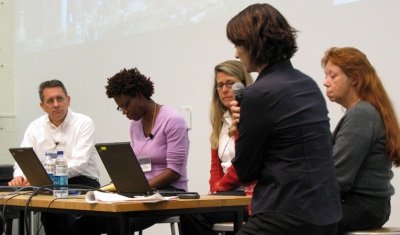Structures for Inclusion was AMAZING. The conference was eye-opening for a lot of people. It was certainly the first conference of its kind to take place at Harvard, and the students at the GSD put a lot of effort into setting it up and making it run smoothly. We had a great representation from Biloxi: nine from the GCCDS, three from Architecture for Humanity, five Mississippi State students, one Minnesota student, and one Hands On volunteer. I finally met the other Design Corps Fellows: Betsy Ramaccia, Megan Clark, Eric Goldman, Jared Hueter, and Ella Scheuer. We more or less got organized on Friday, went to Shigeru Ban’s lecture Friday night, and then had a full day of interesting presentations on Saturday (more below). Sunday morning wrapped things up with a couple of workshops followed by brunch. I hung out with Design Studio folks and Price most of the day Sunday and then went to bed early for my 6am flight on Monday.
It’s hard to quickly digest everything that was covered, but there were definitely some interesting themes, which I’ll try to summarize later. In the meantime, click below for more about the awesome panelists!
Panel I: activist . practice
- David Perkes, Gulf Coast Community Design Studio (Biloxi, MS)
- Liz Ogbu, Public Architecture, (San Francisco, CA)
- Carin Smuts, CS Studio Architects (Capetown, South Africa)
- Moderator Laura Miller, Associate Professor of Architecture, Harvard Graduate School of Design
- Patricia Broussard, East Biloxi resident (Biloxi, MS)
David gave an overview of the way we work here in Biloxi. We try to (1) Work close to the need, (2) Create community partnerships, (3) Be useful, and (4) Understand the value of design. Patty gave a great talk about what it’s been like to recover from the hurricane; the audience loved her. Liz Ogbu showed some cool projects that Public Architecture is doing; I can’t summarize them well here, but check out their Day Labor Station, Scrap House, and 1% Program. And finally Carin talked about the challenges and issues of working in Capetown, South Africa and showed some amazing community center projects.
– – –
Panel II: political . art
- John Fetterman, Mayor (Braddock, PA)
- Amy Balkin, Invisible 5 (San Francisco, CA)
- Dan Adams, Landing Studio (Cambridge, MA)
- Moderator Lonni Tanner, Loeb Fellow (Not shown)
The second panel encompassed a wide range of work. John is the mayor of an industrial town, Amy is an artist working to expose environmental and social problems, and Dan is a provocative designer working in the ambiguous space between the salt industry and a community.
Braddock, PA, is a town near Pittsburgh that has lost 90% of its population and most of its stores and amenities since its peak. Mayor John Fetterman is working to engage remaining residents as well as interested outsiders to turn its many disadvantages, such as abandoned buildings and low property values, into possibilities for reinvention. Along the I-5 corridor in California, Amy Balkin has helped create a very interesting oral history project called Invisible 5 that functions as an eye-opening driving tour of the corridor. In Cambridge, Dan Adams’ work has helped make the salt industry more visible and accessible and is creating a dialogue with the community.
– – –
Panel III: social . sustainability
- Jim Diers, Department of Neighborhoods (Seattle, WA)
- Simon Trace, Practical Action (Rugby, UK)
- Jennifer Toy and Chelina Ogbert, Kounkuey Design Initiative (Cambridge, MA and Nairobi, Kenya)
- Moderator Hashim Sarkis, Aga Khan Professor, Harvard Graduate School of Design (Not shown)
Jim Diers gave a very enthusiastic talk about community organizing, and particularly the Neighborhood Matching Funds Program he created in Seattle, a model that has spread to many other cities. The program encourages neighborhoods to come up with their own projects, then matches city money to their contributions of donated labor, goods, and funds. Simon Trace talked about Practical Action‘s efforts to tackle global warming and sustainable energy through development of appropriate technologies. And Jennifer and Chelina showed some of their work in Kibera, a slum in Nairobi, Kenya, in which small-scale interventions can still help address issues like pollution and flooding.
– – –
Panel IV: design . power
- Moderator Rahul Mehrotra, Associate Professor, School of Architecture + Planning, MIT
- Teddy Cruz, Estudio Teddy Cruz (San Diego, CA)
- Alfredo Brillembourg and Hubert Klumpner, Urban Think Tank (Caracas, Venezuela)
Finally, Estudio Teddy Cruz and Urban Think Tank are both looking at parts of the world where border issues and inequality are pressing. Teddy talked about the political equator, a boundary zone with more than its fair share of tension, migration, inequality, and conflict. His work in the Tijuana-San Diego area looks at these issues on a local scale. Urban Think Tank operates in Caracas, Venezuela, where the division between modern metropolis and crowded mountainside slum is incredibly stark. Using provocative graphics and radical proposals such as a slum cable car system and an under-highway orphanage, Urban Think Tank looks at critical areas not as blight but as opportunity.












